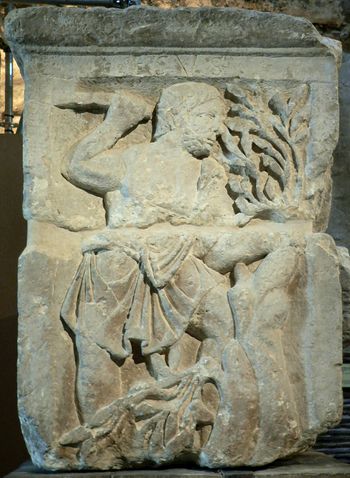「エスス」の版間の差分
| 33行目: | 33行目: | ||
[[Miranda Green (academic)|Miranda Green]] suggests that the willow-tree that Esus hews may symbolize "the Tree of Life [...] with its associations of destruction and death in winter and rebirth in the spring".<ref name="miranda"/> She further suggests that the cranes might represent "the flight of the soul (perhaps the soul of the tree)".<ref name="miranda"/> | [[Miranda Green (academic)|Miranda Green]] suggests that the willow-tree that Esus hews may symbolize "the Tree of Life [...] with its associations of destruction and death in winter and rebirth in the spring".<ref name="miranda"/> She further suggests that the cranes might represent "the flight of the soul (perhaps the soul of the tree)".<ref name="miranda"/> | ||
| − | |||
| − | |||
| − | |||
| − | |||
| − | |||
| − | |||
| − | |||
==See also== | ==See also== | ||
2022年11月15日 (火) 21:55時点における版

エスス(Esus)[1]、ヘスス(Hesus)[2]、あるいはアイサス(Aisus[3])はブリトン人とガリア人の神で、二つの記念像とルカヌスの叙事詩『ファルサリア』の一節で知られている。
名前
T. F. O'Rahillyは、Aoibheall、Éibhleann、Aoifeなどの名前と同様に、Esusという名称をインド・ヨーロッパ語族の原語である*eis-に由来し、これを「幸福、エネルギー、情熱」と訳している[4]。
エスナートゥス(Esunertus、「エススの力」)という個人名は、マーキュリーに捧げられた奉納碑文を含むガロ・ローマ時代の多くの碑文に登場する[5][6]。またエスゲヌス(Esugenus、「エススから生まれた」)などの神話的な名前も確認されている[7]。現在のノルマンディー地方にあるガリアのエスヴィー族はエススから名前を取った可能性がある[8]。
図像
エススが登場する彫刻は、エススが名指しで描かれたパリの「船乗りの柱」[1]と、同様の図像を持つトレヴェリの「トリア」の柱の二つである[9][10]。いずれも、エススは斧で木の枝を切っている姿が描かれている[10]。エススは、「船乗りの柱」の別のパネルで、タルボス・トリガラヌス(「三羽の鶴を持つ雄牛」)、ユピテル、ヴァルカン、その他の神々と一緒に描かれている。
文献資料
有名なルカヌスの「ファルサリア」(61-65CE)の一節は、テウタテス、ヘスス(エススの吸引形)、タラニスというケルトの三神に捧げられた痛ましい生け贄について言及している[2]。ルカヌスの写本には、ヘスス(Hesus)、アイサス(Aesus)、ハエサス(Haesus)など、エススという名前の異表記や読み方がある[7]。ルカヌスの作品を解説した後世の二人の論者のうち、一人はテウタテスを水星、エススを火星と同定している。ベルンの『ルカヌス伝』によれば、人間の犠牲者は木に縛られ、鞭で打たれて死ぬことでエススの生贄とされた[11]。
ガリア人の医学者ボルデックスのマルケウス(Marcellus of Bordeaux)は、5世紀初頭にラテン語で書かれた薬学的製剤の大要『メディカメンティス(De medicamentis)』において、エススに関するもう一つの文献を提示しているようだ。この作品には、喉の病気を治すためにエスス(アイサスと表記)の助けを求めると思われるガリア語と判読できる魔術的な医学的な呪文が含まれている[3]。
解説
ジョン・アーノット・マッカロク(John Arnott MacCulloch)は、1911年当時、エススに関する学術的な解釈を次のようにまとめた。
M.レイナッハ(M. Reinach)はエススの祭壇の主題を一定の形式で表現している。"The Divine Woodman hews the Tree of the Bull with Three Cranes"(『木こりの神は三羽の鶴と共に雄牛の木を切る。』)全体は未知の神話を表しているが、ダルボア氏はこの中にクー・フーリンの物語(Cúchulainn saga)の内容との関連性を見出している。イメージとしては、牛と木はおそらく両方とも神であり、もしこの動物が神の牛のイメージのように3つの角を持っているとすれば、3羽の鶴(garanus、「鶴」)は、3つの角(trikeras)、あるいはより正確には3頭(trikarenos)のリバスである可能性がある。この場合、木こり、木、牛はすべて植生の神の代表かもしれない[私注 1]。初期の儀式では、豊穣を確保するために、人間や動物、樹木などの神の代表を定期的に破壊したが、神がこれらの代表から離れると、破壊や殺害は神への犠牲とみなされ、かつて動物が殺されたことを伝える神話が生まれた[私注 2]。この場合、本当に同じものである木と牛は、かつて彼らが象徴していた神によって破壊されたと神話的にみなされることになる[私注 3]。もしエススが植物神で、かつては木に象徴されていたとすれば、ルカヌスの「ファルサリア」が伝えるように、エススへの人間の生け贄が木に吊るされていたことが説明できるだろう[私注 4]。エススはパリとトリーヴで崇拝され、イングランドではエススの名を持つコインが発見された。また、イングランド、フランス、スイスでは、エスゲノス(エスースの息子)、エスナートス(エスースの力を持つ者)といった人名が登場する。このように、この神への信仰は比較的広く行われていたと思われる。
John Arnott MacCulloch summarized the state of scholarly interpretations of Esus in 1911 as follows:
M. Reinach applies one formula to the subjects of these altars—"The Divine Woodman hews the Tree of the Bull with Three Cranes." The whole represents some myth unknown to us, but M. D'Arbois finds in it some allusion to events in the Cúchulainn saga. In the imagery, the bull and tree are perhaps both divine, and if the animal, like the images of the divine bull, is three-horned, then the three cranes (garanus, "crane") may be a rebus for three-horned (trikeras), or more probably three-headed (trikarenos). In this case, woodman, tree, and bull might all be representatives of a god of vegetation. In early ritual, human, animal, or arboreal representatives of the god were periodically destroyed to ensure fertility, but when the god became separated from these representatives, the destruction or slaying was regarded as a sacrifice to the god, and myths arose telling how he had once slain the animal. In this case, tree and bull, really identical, would be mythically regarded as destroyed by the god whom they had once represented. If Esus was a god of vegetation, once represented by a tree, this would explain why, as the scholiast on Lucan relates, human sacrifices to Esus were suspended from a tree. Esus was worshipped at Paris and at Trèves; a coin with the name Æsus was found in England; and personal names like Esugenos, "son of Esus," and Esunertus, "he who has the strength of Esus," occur in England, France, and Switzerland. Thus the cult of this god may have been comparatively widespread. But there is no evidence that he was a Celtic Jehovah or a member, with Teutates and Taranis, of a pan-Celtic triad, or that this triad, introduced by Gauls, was not accepted by the Druids. Had such a great triad existed, some instance of the occurrence of the three names on one inscription would certainly have been found. Lucan does not refer to the gods as a triad, nor as gods of all the Celts, or even of one tribe. He lays stress merely on the fact that they were worshipped with human sacrifice, and they were apparently more or less well-known local gods.[5]
___{{{author}}}
James McKillop cautions that Arbois de Jublainville's identification of Esus with Cú Chulainn "now seems ill-founded".[12]
Jan de Vries finds grounds of comparison between Esus and Odin, both being patrons of sailors sometimes associated with Mercury to whom human victims were said to be sacrificed by hanging.[8]
Miranda Green suggests that the willow-tree that Esus hews may symbolize "the Tree of Life [...] with its associations of destruction and death in winter and rebirth in the spring".[10] She further suggests that the cranes might represent "the flight of the soul (perhaps the soul of the tree)".[10]
See also
External links
- Esus, including photographs and a capitulation of primary and secondary source material.
- A contemporary Dutch-language story of struggle between Esus and Tarvos Trigaranus
私的注釈
- ↑ これは違うと思う。木こりの神は桂男、牛、木、鳥は中国的な月桂樹でもあり死んだ蚩尤の象徴というべきと考える。木こりと切られるものが「別のもの」である点が大きな問題となっていると感じる。
- ↑ 何を言っているのやら、と個人的には思う。まずは、なんで何かを破壊したら豊穣が得られると思うのか、筆者は自分の思考を整理すべきと思う。エススは戦闘における殺害と略奪を煽る神であるし、クー・フーリンを引き合いに出すのも、戦闘で異形に変身して恐るべき殺害者となるクー・フーリンを指していると思うのだが。これは「木こり」の神が、余所の部族の牡牛、木、鳥(要は余所の部族の世界樹=世界)を切り倒し、破壊しつくせ、と言っている図であると管理人は考える。その元になった神話は黄帝が炎帝(牡牛であり樹木神であるもの)を倒したという歴史的事実を神話化したものと考えるが、そもそも黄炎は他人同士なので、こういう「殺戮と略奪を正当化する理屈」に援用されてしまったものと考える。その源は、川の神が川の神を倒す、というような矛盾した神話である祝融と共工の戦いのように思う。日本の須佐之男命と八俣遠呂智の神話もこの部類に入る。こういう理屈がまかり通るようになると、同族同士でもちょっとした違いをあげつらってお互いに攻撃し合うことも正当化できるようになってしまうのではないだろうか。
- ↑ この文も間違った内容を含むと管理人は考える。
- ↑ これはむしろ「吊された人間」の方が植物の化身と考えられたからではないか、と考える。
参照
- ↑ 1.0 1.1 CIL, 13, 03026
- ↑ 2.0 2.1 M. Annaeus Lucanus (61-65 CE). Bellum civile I.445.
- ↑ 3.0 3.1 De medicamentis 15.106, p. 121 in Niedermann's edition; Gustav Must, “A Gaulish Incantation in Marcellus of Bordeaux,” Language 36 (1960) 193–197; Pierre-Yves Lambert, “Les formules de Marcellus de Bordeaux,” in La langue gauloise (Éditions Errance 2003), p.179, citing Léon Fleuriot, “Sur quelques textes gaulois,” Études celtiques 14 (1974) 57–66.
- ↑ T. F. O'Rahilly, 1946, Ir. Aobh, Aoibheall, etc. W. ufel, uwel. Gaul. Esus, Ériu, Royal Irish Academy, volume14 , pages1–6, jstor:30007645
- ↑ 5.0 5.1 J. A. MacCulloch (1911). ‘Chapter III. The Gods of Gaul and the Continental Celts.’ The Religion of the Ancient Celts. New York: Dover Publications., ISBN:0-486-42765-X.
- ↑ CIL, 13, 11644
- ↑ 7.0 7.1 Jean Gricourt, 1958, L’Esus de Pétrone, Latomus, Société d’Études Latines de Bruxelles, volume17, pages102–109 , jstor:41518785
- ↑ 8.0 8.1 Jan de Vries (1954). Keltische Religion. W. Kohlhammer, Stuttgart. p.98. Cited here.
- ↑ Proinsias Mac Cana, Celtic Mythology, Hamlyn Publishing , London, 1970, pages32–35 Cited here (retrieved 2016-08-17).
- ↑ 10.0 10.1 10.2 10.3 Miranda Green, Symbol & Image in Celtic Religious Art, 1992, Routledge , London , pages103–104
- ↑ Olmsted, Garrett S., The gods of the Celts and the Indo-Europeans, University of Innsbruck, 1994, p. 321.
- ↑ テンプレート:Cite book Cited here (retrieved 2016-08-17).